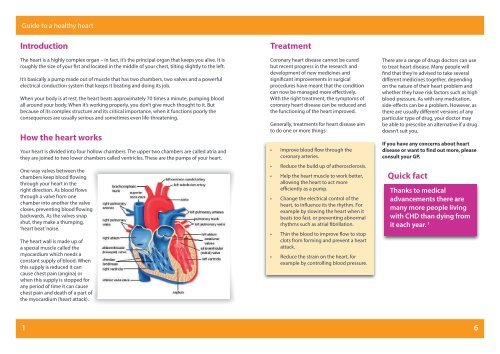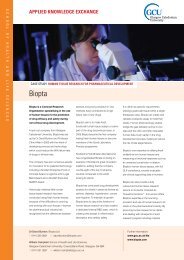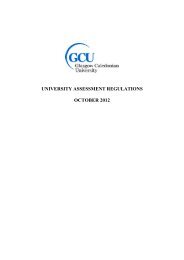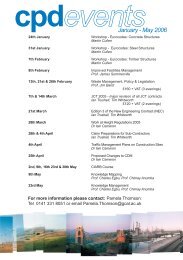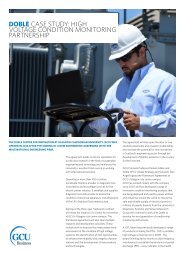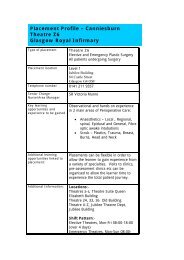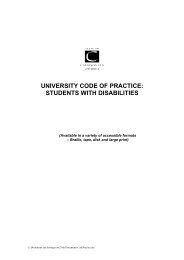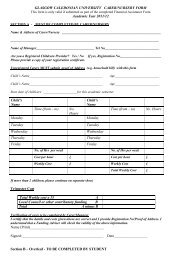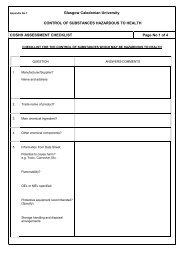Healthy Heart OH Leaflet
Healthy Heart OH Leaflet
Healthy Heart OH Leaflet
You also want an ePaper? Increase the reach of your titles
YUMPU automatically turns print PDFs into web optimized ePapers that Google loves.
Guide to a healthy heart<br />
Introduction<br />
The heart is a highly complex organ – in fact, it’s the principal organ that keeps you alive. It is<br />
roughly the size of your fist and located in the middle of your chest, tilting slightly to the left.<br />
It’s basically a pump made out of muscle that has two chambers, two valves and a powerful<br />
electrical conduction system that keeps it beating and doing its job.<br />
When your body is at rest, the heart beats approximately 70 times a minute, pumping blood<br />
all around your body. When it’s working properly, you don’t give much thought to it. But<br />
because of its complex structure and its critical importance, when it functions poorly the<br />
consequences are usually serious and sometimes even life-threatening.<br />
How the heart works<br />
Your heart is divided into four hollow chambers. The upper two chambers are called atria and<br />
they are joined to two lower chambers called ventricles. These are the pumps of your heart.<br />
One-way valves between the<br />
chambers keep blood flowing<br />
through your heart in the<br />
right direction. As blood flows<br />
through a valve from one<br />
chamber into another the valve<br />
closes, preventing blood flowing<br />
backwards. As the valves snap<br />
shut, they make a thumping,<br />
‘heart beat’ noise.<br />
The heart wall is made up of<br />
a special muscle called the<br />
myocardium which needs a<br />
constant supply of blood. When<br />
this supply is reduced it can<br />
cause chest pain (angina) or<br />
when this supply is stopped for<br />
any period of time it can cause<br />
chest pain and death of a part of<br />
the myocardium (heart attack).<br />
Treatment<br />
Coronary heart disease cannot be cured<br />
but recent progress in the research and<br />
development of new medicines and<br />
significant improvements in surgical<br />
procedures have meant that the condition<br />
can now be managed more effectively.<br />
With the right treatment, the symptoms of<br />
coronary heart disease can be reduced and<br />
the functioning of the heart improved.<br />
Generally, treatments for heart disease aim<br />
to do one or more things:<br />
• Improve blood flow through the<br />
coronary arteries.<br />
• Reduce the build up of atherosclerosis.<br />
• Help the heart muscle to work better,<br />
allowing the heart to act more<br />
efficiently as a pump.<br />
• Change the electrical control of the<br />
heart, to influence its the rhythm. For<br />
example by slowing the heart when it<br />
beats too fast, or preventing abnormal<br />
rhythms such as atrial fibrillation.<br />
• Thin the blood to improve flow to stop<br />
clots from forming and prevent a heart<br />
attack.<br />
• Reduce the strain on the heart, for<br />
example by controlling blood pressure.<br />
There are a range of drugs doctors can use<br />
to treat heart disease. Many people will<br />
find that they’re advised to take several<br />
different medicines together, depending<br />
on the nature of their heart problem and<br />
whether they have risk factors such as high<br />
blood pressure. As with any medication,<br />
side-effects can be a problem. However, as<br />
there are usually different versions of any<br />
particular type of drug, your doctor may<br />
be able to prescribe an alternative if a drug<br />
doesn’t suit you.<br />
If you have any concerns about heart<br />
disease or want to find out more, please<br />
consult your GP.<br />
Quick fact<br />
Thanks to medical<br />
advancements there are<br />
many more people living<br />
with CHD than dying from<br />
it each year. 1<br />
1<br />
6


